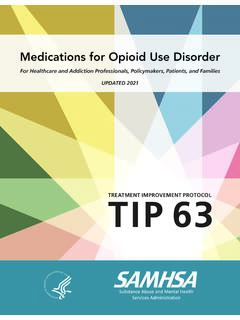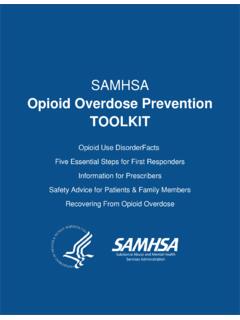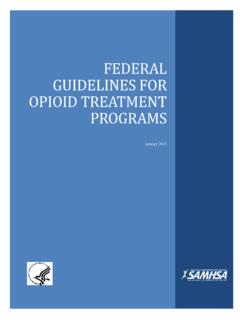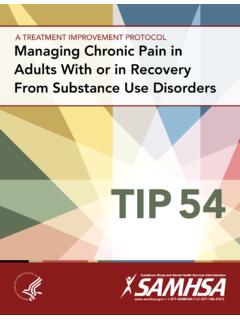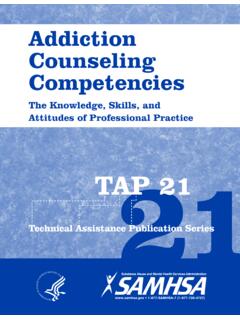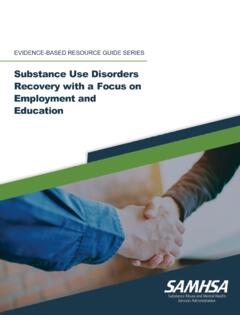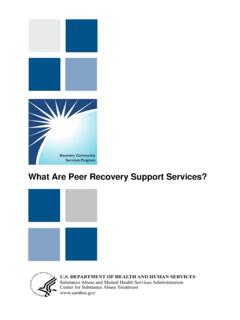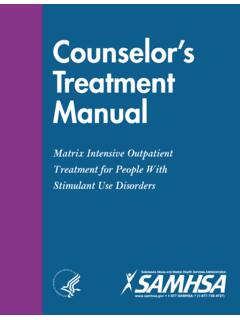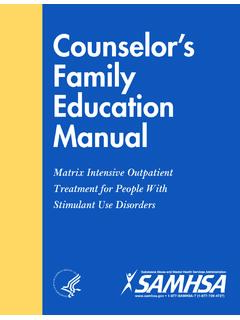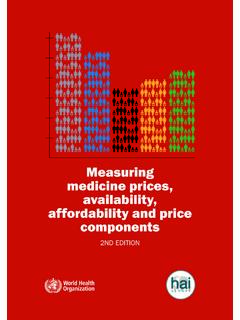Transcription of Interventions for Disruptive Behavior Disorders: Evidence ...
1 Evidence -Basedand Promising PracticesInterventions for Disruptive Behavior DisordersEvidence-Basedand Promising Department of Health and Human Services Substance Abuse and Mental Health Services AdministrationInterventions for Disruptive Behavior DisordersAcknowledgmentsThis document was produced for the Substance Abuse and Mental Health Services Administration (SAMHSA) by Abt Associates, Inc., and the National Association of State Mental Health Program Directors (NASMHPD) Research Institute (NRI) under contract number 280-2003-00029 with SAMHSA, Department of Health and Human Services (HHS). Sylvia Fisher and Pamela Fischer, , served as the Government Project views, opinions, and content of this publication are those of the authors and contributors and do not necessarily reflect the views, opinions, or policies of the Center for Mental Health Services (CMHS), SAMHSA, or Domain NoticeAll material appearing in this document is in the public domain and may be reproduced or copied without permission from SAMHSA.
2 Citation of the source is appreciated. However, this publication may not be reproduced or distributed for a fee without the specific, written authorization from the Office of Communications, SAMHSA, Access and Copies of PublicationThis publication may be downloaded or ordered at Or, please call SAMHSA s Health Information Network at 1-877-SAMHSA-7 (1-877-726-4727) (English and Espa ol).Recommended CitationSubstance Abuse and Mental Health Services Administration. Interventions for Disruptive Behavior Disorders: Evidence -Based and Promising Practices. HHS Pub. No. SMA-11-4634, Rockville, MD: Center for Mental Health Services, Substance Abuse and Mental Health Services Administration, Department of Health and Human Services, Office Center for Mental Health Services Substance Abuse and Mental Health Services Administration 1 Choke Cherry Road Rockville, MD 20857 HHS Publication No.
3 SMA-11-4634 Printed 2011 Evidence -Based and Promising PracticesThis booklet provides indepth information about each intervention to help stakeholders identify and select Evidence -based practices (EBPs) that might best fit the needs and preferences of communities, providers, practitioners, families, and references, see the booklet, The for Disruptive Behavior DisordersThis KIT is part of a series of Evidence -Based Practices KITs created by the Center for Mental Health Services, Substance Abuse and Mental Health Services Administration, Department of Health and Human booklet is part of the Interventions for Disruptive Behavior Disorders KIT, which includes six booklets.
4 How to Use the Evidence -Based Practices KITsCharacteristics and Needs of Children with Disruptive Behavior Disorders and their FamiliesSelecting Evidence -Based Practices for Children with Disruptive Behavior Disorders to Address Unmet Needs: Factors to Consider in DecisionmakingImplementation ConsiderationsEvidence-Based and Promising PracticesMedication ManagementWhat s in Evidence -Based Practice and Promising Practices Introduction ..1 Triple P Positive Parenting Program ..3 Project ACHIEVE ..11 Second Step ..19 Promoting Alternative Thinking Strategies ..25 First Steps to Risers: Skills for Success ..37 Adolescent Transitions Program.
5 43 Incredible Years ..49 Helping the Noncompliant Child ..55 Parent-Child Interaction Therapy ..61 Parent Management Training Oregon ..67 Brief Strategic Family Therapy ..73 Problem-Solving Skills Training ..79 Coping ..89 Multisystemic Therapy ..95 Functional Family Therapy ..107 Multidimensional Treatment Foster Care ..113 Interventions for Disruptive Behavior DisordersEvidence-Based and Promising Practices 1 Evidence -Based and Promising PracticesIntroductionIn Selecting Evidence -Based Practices for Children with Disruptive Behavior Disorders to Address Unmet Needs: Factors to Consider in Decisionmaking in this KIT, several tables summarize information about some of the main features of the KIT s 18 EBPs.
6 This booklet has indepth information about each intervention to help stakeholders identify and select EBPs that might best fit the needs and preferences of communities, providers, practitioners, families, and youth. 18 Evidence -Based Practices Summarized in This BookletPrevention / MultilevelIntervention Triple P Positive Parenting Program Project ACHIEVE Second Step Promoting Alternative Thinking Strategies First Steps to Success Early Risers: Skills for Success Adolescent Transitions Program Incredible Years Helping the Noncompliant Child Parent Child Interaction Therapy Parent Management Training Oregon Brief Strategic Family Therapy Problem-Solving Skills Training Coping Power Mentoring Multisystemic Therapy Functional Family Therapy Multidimensional Treatment Foster Care 2 Evidence -Based and Promising PracticesThe Interventions are each presented in the same format with the following
7 Information, when applicable: Intervention Description Background Characteristics of the intervention Research Base and Outcomes Implementation and Dissemination Infrastructure issuesTraining/coaching and materialsCost of training/consultingDeveloper involvementMonitoring fidelity and outcomesFinancing the intervention Resources/Links ReferencesThe Intervention Description covers background information about the origin of the intervention, the developers, the population of interest, and essential characteristics of the key part of Research Base and Outcomes for each EBP is a summary table that allows for quick access to information about the researchers, the design, and outcomes.
8 These tables include important information from relevant studies, and culturally and linguistically relevant information from the research studies is highlighted. For most Interventions , this means that the populations used in the studies have been noted. For some, this means that research on cultural and linguistic adaptations of the intervention has been included. For example, the booklet notes that a culturally adapted version of Parent Management Training Oregon is being evaluated with Spanish-speaking Latino parents and is called Nuestras and Dissemination covers such topics as: infrastructure issues, training/coaching and materials, the cost of training/consultations, current developer involvement and contact information, the monitoring of fidelity and outcomes, and means of financing the intervention.
9 This information was obtained in large part through telephone interviews with the developers of the EBPs and was then verified through edits and intervention concludes with information about applicable Resources, including Web links, and a list of and Promising Practices 3 Intervention DescriptionBackgroundTriple P Positive Parenting Program is a multi-level system of parenting and family support programs that apply to prevention, early intervention, and treatment. Triple P was developed by Matthew R. Sanders, , and colleagues from the Parenting and Family Support Centre in the School of Psychology, University of Queensland in the past few years, Triple P has been disseminated to approximately 25 organizations within the United States and to 15 countries.
10 Dissemination has been carried out as follows: Statewide in Wyoming as the centerpiece of the Wyoming Parenting Initiative (more than 500 practitioners trained to date). In 18 counties in South Carolina through the Triple P System Population Trial. Funded by the Centers for Disease Control and Prevention, this trial is being conducted by the University of South Carolina and the University of Queensland. At the Children s Medical Center of Akron, Ohio, and other parts of Ohio. Through organizations in California, Delaware, Florida, Georgia, Missouri, and Pennsylvania. In 14 countries in North America, Europe, and the Asia-Pacific region, where Triple P International is 1 Triple P Positive Parenting ProgramType of EBP Prevention/MultilevelSetting Clinic Home SchoolAge 0 16 Gender Males FemalesTraining/Materials Available Ye sOutcomes Increase in parental confidence Improvements in dysfunctional parenting styles Reduction in child Behavior problemsCharacteristics of the interventionTriple P aims to prevent or reduce severe behavioral, emotional, and developmental problems in children by enhancing the knowledge, skills, and confidence of parents.

